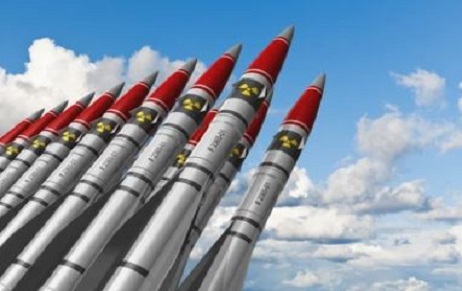INTRODUCTION Being applicable in many ways virtual reality or VR has now revolutionized several industries…
India Nuclear Doctrine
ABSTRACT
Nuclear capacity is the principal focus of international affairs in the twenty-first century. To maximise the impact of a nuclear arsenal, a state must have intelligible and respectable doctrines or policies in place to create legitimacy and a defined threshold for deployment. The purpose of this study is to examine India’s nuclear policy, which is dedicated to a No First Use posture. This stance not only ensures India’s security in an anarchic world, but also qualifies it as a responsible nuclear weapon state, allowing it to properly manage its nuclear arsenal. Furthermore, this paper critically evaluates major components of India’s draft nuclear policy.
INTRODUCTION
A doctrine is a collection of views or concepts shared by a group of individuals. A national nuclear doctrine is the nation’s collective set of views or principles about the value of its nuclear weapons.[1]Beliefs and ideals are not unchangeable.
A nuclear doctrine defines the purpose, development, and deployment of nuclear weapons, as well as their intended use. The weapon’s function in security policy is conceptualised, determining whether it is a tool of war or a political deterrent. [2]
As India advances its nuclear arsenal, the international community in general, and South Asia in particular, is concerned about what this could mean for future conflicts, given that it shares borders with two nuclear-capable neighbours who have territorial disputes with India, as well as India’s position as a global actor.
INDIA BECOMING A NUCLEAR POWER
Nuclear science and technology have been at the forefront of India’s growth since independence in 1947. The excellent friendship between India’s first Prime Minister, Jawaharlal Nehru, and Dr. Homi Bhabha, the creator of the country’s nuclear programme, helped to avoid bureaucratic interference in developing the program’s workforce and infrastructure. In 1945, the Tata Trust established the Tata Institute of Fundamental Research (TIFR) with Bhabha as its director to conduct fundamental research in nuclear sciences. In 1948, the Indian Constituent Assembly approved the Atomic Energy Act, establishing the Atomic Energy Commission (AEC) shortly after independence. In 1954, the Department of Atomic Energy (DAE) was established under the AEC to oversee all nuclear operations in India, both civilian and military.[3]
[Image Sources: Shutterstock]
In May 1974, India staged an underground nuclear explosion, marking the country’s first effort to test a nuclear weapon. India, which first aimed to use nuclear energy for benign purposes, has compelling reasons to pursue nuclear power. Prominent among them were the injustices India observed in the then-emerging nuclear non-proliferation regime, with the Non-Proliferation Treaty (NPT) of 1970 having given a specifically elevated status to five nuclear-weapon nations, including China. Nuclear weapons became the new currency of power and prestige, relegating many capable nations, including India, to a secondary role. India refused to join the NPT and instead chose to forge its own road.
India’s decision makers were surprised by the strong reaction from Canada and the US to its nuclear test. Within four days following the test, Canada halted all support to India for the RAPS nuclear units and demanded IAEA safeguards for all Indian nuclear sites. In May 1976, Canada ended its nuclear collaboration with India due to their refusal to cooperate. Since 1974, India has been unable to get necessary components and equipment for the RAPS-2 reactor, forcing it to complete the project independently.[4]
The US reacted aggressively to India’s perceived violation of the nuclear non-proliferation framework, which was being shaped under US guidance. The Zangger Committee, a group of 20 nations, established a “trigger list” of things that cannot be exported unless the destination state agrees to IAEA safeguards on the intended installations. In the mid-1970s, the United States formed the Nuclear Suppliers Group (NSG) to impose limitations on a wide range of commodities. The NSG’s post-1992 limitations required countries acquiring nuclear materials to adopt IAEA safeguards for all sites. In response to the Indian bomb test in 1974, the US Congress passed the Nuclear Non-Proliferation legislation (NNPA) in 1978. This legislation prohibits the sale of nuclear materials to countries that do not adhere to IAEA safeguards for their nuclear operations. The NNPA prohibits exports to non-nuclear weapon states that have detonated nuclear devices, primarily targeting India.[5]
The US withdrew from supplying enriched uranium fuel for the Tarapur reactors after the NNPA was passed. This was due to India’s refusal to accept full-scope IAEA safeguards on all nuclear sites in India. The US government prohibited General Electric Company from sending replacement parts to India and providing technical support for the TAPS reactors. After the US withdrew, France agreed to furnish gasoline for a while. Following the 1992 NSG regulations, the French ceased providing nuclear fuel to TAPS. Despite not being a member of the NSG, China stepped in to aid India with petroleum delivery.
However, after India’s nuclear tests in May 1998, China refused to deliver further fuel. In 2001, Russia and India signed a deal to deliver enriched uranium for TAPS, and the first fuel shipment arrived in India. [6]The US fiercely opposed this arrangement, but Russia refused to change the pact with India. India has tested irradiating fuel subassemblies with mixed oxides of uranium and plutonium (MOX) in TAPS reactors to partially replace enriched uranium fuel.
IMPORTANT INTERNATIOAL DISARMAMENT AGREEMENT
In the late 1940s, only the nuclear programme was launched in India. The continued testing of atomic and hydrogen bombs raised concerns about radioactive fallout, prompting negotiations to cease nuclear testing. The Limited Test Ban Treaty (LTBT) was signed in 1963. This pact prohibited nuclear weapon testing and other nuclear explosions in the atmosphere, outer space, and beneath sea. India also signed and approved the accord.[7]
The Nuclear Non-Proliferation Treaty (NPT) was signed in 1968 and came into force in 1970.The NPT mandates governments to abandon efforts to create nuclear weapons and use nuclear energy for peaceful purposes.
This pact now includes over 190 states. India is one of the five countries that did not sign the NPT.
India opposes the Nuclear Non-Proliferation Treaty (NPT) as it supports the monopoly of the five nuclear countries and views it as discriminatory.
The NPT is a broadly regarded weapons control pact. Few nations, including India, Pakistan, and Israel, have not signed the pact. “The Nuclear Non-Proliferation Treaty obligates the five recognised nuclear weapon nations. China, the United States, the United Kingdom, Russia, and France agreed not to transfer nuclear weapons, explosive devices, or technology to non-nuclear armed states. (Kimball 2020) non-nuclear weapon states agree not to acquire or manufacture nuclear weapons or explosive devices.[8]
The Comprehensive Test Ban Treaty (CTBT), which opened for signing in September 1996, was a significant step towards prohibiting nuclear testing. The CTBT is a global treaty that prohibits nuclear weapons testing and other nuclear explosions. India has stated its willingness to sign the CTBT if certain amendments are made to improve equity.
America has been lobbying India and other nations to sign and ratify the CTBT, but the treaty has yet to enter into force due to a lack of ratification from the required number of countries.
Western nations have been pursuing a one-sided nuclear agenda. They have large stockpiles of nuclear weapons and are unwilling to dismantle them, preferring to maintain their monopoly.
HISTORY OF INDIA NUCLEAR DOCTRINE
After New Delhi’s 1998 nuclear tests, India faced dilemmas and constraints in restructuring its nuclear command and control system. As a responsible nuclear state, India took the first step towards establishing a nuclear command and control system by promulgating a draft nuclear doctrine in August 1999.
The Cabinet Committee on Security (CCS) approved the draft nuclear doctrine and established the Political Council (headed by the Prime Minister) and Executive Council (led by the National Security Advisor). The proposed nuclear doctrine outlines rules for the development, deployment, and employment of Indian nuclear forces. There is continuing discussion about how India should follow these recommendations. India has not issued a formal comment on the status and execution of the draft nuclear policy, which was endorsed by the CCS on January 4, 2003. The Indian government have struck a balance between transparency and opacity.
Why is the nuclear doctrine is needed
A nuclear doctrine explains the rationale for a nation’s nuclear weapons and the philosophy underlying their employment in national defence. These aims can be achieved by explicit enunciation of a concept or clues in vague utterances. Not all nations have publicly shared nuclear doctrines, such as India’s. In certain situations, such as Pakistan, the ideology may only be obtained through public declarations or papers authored by retired military officials, political leaders, or members of the strategic community.[9]
INDIAN NUCLEAR DOCTRINE
Generally, a nuclear policy governs the state’s use of nuclear weapons in both conflict and peace. The International Community strives to eradicate weapons of mass devastation. India aims to attain economic, political, social, and scientific progress by peaceful and democratic means. India prioritises security and pursues credible minimum nuclear deterrence as part of its growth strategy.[10]
India’s nuclear weapons are primarily used to threaten the use of nuclear weapons by any state against it. The country will not use or use nuclear weapons against those that do not have them. India’s nuclear doctrine was entirely retaliatory. Following the 1998 nuclear test, India implemented a “No First Use” policy for nuclear weapons.
Brajesh Mishra, the Indian National Security Advisor, issued a draft nuclear policy on August 17, 1999. Despite its lack of official status, India’s nuclear arsenal has mostly followed the guidelines outlined in the draft treaty (Arms Control Association, 2007).
The draft statement defines the general principles for developing, deploying, and employing India’s nuclear forces. India’s new nuclear document prioritises security through nuclear deterrence.
- Maintaining a credible minimum deterrent
- Using nuclear weapons only in response to a nuclear attack on Indian territory or forces anywhere.
- Massive retaliation to a first strike.
- Nuclear retaliatory attacks can only be authorized by the civilian political leadership through the Nuclear Command Authority.
- Avoiding the use of nuclear weapons against non-nuclear state.
- However, in the case of a catastrophic biological or chemical attack on India or Indian soldiers anywhere, India will be able to respond with nuclear weapons.
- The continuation of rigorous controls on the export of nuclear and missile-related materials and technologies, participation in the Fissile Material Cutoff Treaty discussions, and ongoing adherence of the nuclear test ban.
- Continued commitment to achieving a nuclear-free world through comprehensive, verifiable, and non-discriminatory nuclear disarmament.
CONCLUSION
“Doctrines dominate men’s brains only during non-emergency situations. During emergency situations, men’s brains may not be within their control. When the threat of massive disaster arises, one might expect to see abrupt shifts in theology.” This was expressed by James Schlesinger during a hearing before the US Senate Committee on Foreign Relations, 93rd Congress, 1974.38 This notion might be even more accurate in the case of nuclear doctrines, but because the world has managed to avoid the use of nuclear weapons, there are no actual examples to test or contradict this premise. However, it is important to note that teachings are not set in stone. They represent current political, economic, and technical realities, which may alter as these factors evolve.
A nuclear doctrine provides insight into a country’s perception of its nuclear weapons. It explains why it needs these weapons of mass destruction and how it intends to use them to achieve its goals. India has based its need for nuclear weapons on its intention to oppose nuclear coercion or blackmail, and so envisions their use solely for self-defence. As a result, New Delhi has issued a nuclear policy in which its nuclear weapons are viewed solely as a political deterrent. India’s nuclear doctrine follows a no-first-use policy, stating that nuclear weapons should only be used if an adversary has first used them against the country. They do not play a role in enforcing or staging aggression. In such a case, the theory recommends ensuring reprisal to cause intolerable harm. The policy aims for a credible minimum nuclear deterrent based on survival.[11]
India’s operational nuclear strategy, based on its nuclear doctrine, offers the least risky alternative in the presence of nuclear weapons. This approach to nuclear deterrence relies on a modest arsenal that is less vulnerable to miscalculation or unintentional use. The ideology prioritises no first use and punitive reprisal, aiming to reduce the likelihood of nuclear use.
India’s nuclear doctrine prioritises achieving a NWFW as the most effective means of ensuring its security. An NWFW can enhance India’s regional and global security, allowing it to pursue economic and security objectives with strategic autonomy. In the meanwhile, India’s nuclear deterrent, as stated by its policy, will suffice.
Author: Aditya Raj, A Student at Bharati Vidyapeeth New Law Collage Pune, in case of any queries please contact/write back to us via email to [email protected] or at IIPRD.
[1] Colonel Gurmeet Kanwal, ‘India’s Nuclear Doctrine and Policy’ [2001] Strategic Analysis < https://ciaotest.cc.columbia.edu/olj/sa/sa_feb01kag01.html>
[2] MAHESH SHANKAR, ‘Nuclear doctrines and stable strategic relationships: the case of south Asia’ Vol. 92, No. 1 (January 2016), pp. 1-20 (20 pages)
[3] Bakhtiar K. Dadabhoy, ‘Homi Bhabha, Jawaharlal Nehru and the Bomb’ [2023] <https://thewire.in/books/homi-bhabha-jawaharlal-nehru-and-the-bomb>
[4] MAHESH SHANKAR, ‘Nuclear doctrines and stable strategic relationships: the case of south Asia’ Vol. 92, No. 1 (January 2016)
[5] George Perkovich, ‘A Strategy for Nuclear Security’[2007] < https://carnegieendowment.org/files/univ_comp_rpt07_final1.pdf>
[6] PREMESHA SAHA, ‘The 1998 Pokhran nuclear tests: reactions and responses from the Indo-Pacific’ [May 11, 2023] < https://www.orfonline.org/expert-speak/the-1998-pokhran-nuclear-tests> 05 Feb 2024
[7] Lawrence D. Freedman, ‘Nuclear Test-Ban Treaty’ <https://www.britannica.com/event/Nuclear-Test-Ban-Treaty> 05 Feb 2024
[8] George Perkovich, ‘NON-WEAPONIZED DETERRENCE: THE CASE FOR PAKISTAN’ < https://www.jstor.org/stable/45182162> Vol. 17, No. 1/2 pp. 138-169.
[9] MANPREET SETHI, ‘INDIA’S NUCLEAR DOCTRINE:THE BASIS FOR CREDIBLE DETERRENCE’ < https://capsindia.org/wp-content/uploads/2022/10/Manpreet–Sethi-3.pdf> 05 Feb 2024
[10] Etel Solingen, ‘The Political Economy of Nuclear Restraint’ Vol. 19, No. 2 (Fall, 1994), pp. 126-169
[11] Scott D. Sagan, ‘Why Do States Build Nuclear Weapons?: Three Models in Search of a Bomb’ Vol. 21, No. 3 (Winter, 1996-1997), 05 Feb 2024



